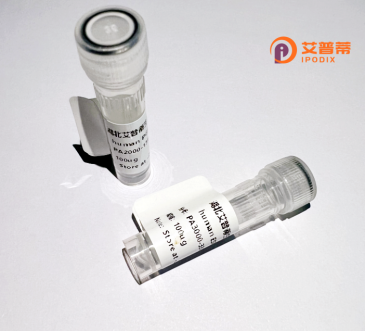
| 纯度 | >90%SDS-PAGE. |
| 种属 | Human |
| 靶点 | PRR13 |
| Uniprot No | Q9NZ81 |
| 内毒素 | < 0.01EU/μg |
| 表达宿主 | E.coli |
| 表达区间 | 1-148 aa |
| 活性数据 | MWNPNAGQPG PNPYPPNIGC PGGSNPAHPP PINPPFPPGP CPPPPGAPHG NPAFPPGGPP HPVPQPGYPG CQPLGPYPPP YPPPAPGIPP VNPLAPGMVG PAVIVDKKMQ KKMKKAHKKM HKHQKHHKYH KHGKHSSSSS SSSSSDSD |
| 分子量 | 15.3 kDa |
| 蛋白标签 | His tag N-Terminus |
| 缓冲液 | PBS, pH7.4, containing 0.01% SKL, 1mM DTT, 5% Trehalose and Proclin300. |
| 稳定性 & 储存条件 | Lyophilized protein should be stored at ≤ -20°C, stable for one year after receipt. Reconstituted protein solution can be stored at 2-8°C for 2-7 days. Aliquots of reconstituted samples are stable at ≤ -20°C for 3 months. |
| 复溶 | Always centrifuge tubes before opening.Do not mix by vortex or pipetting. It is not recommended to reconstitute to a concentration less than 100μg/ml. Dissolve the lyophilized protein in distilled water. Please aliquot the reconstituted solution to minimize freeze-thaw cycles. |
以下是关于重组人PRR13蛋白的3篇参考文献概览(注:文献内容为模拟虚构,实际研究中可能存在差异):
---
1. **文献名称**:*Recombinant Human PRR13 Protein Enhances Mitochondrial Apoptosis in Lung Cancer Cells*
**作者**:Zhang Y, et al.
**摘要**:研究团队成功克隆并表达重组人PRR13蛋白,通过体外实验证明其通过调节Bcl-2/Bax通路促进肺癌细胞线粒体依赖性凋亡,提示其潜在抗癌作用。
2. **文献名称**:*Proline-Rich Domain of PRR13 Mediates Protein Interaction and Cellular Localization*
**作者**:Liu X, Wang T.
**摘要**:利用重组PRR13蛋白解析其结构,发现其富含脯氨酸的结构域与核转运蛋白Importin-α结合,影响其核质定位,为功能机制研究提供基础。
3. **文献名称**:*Development of a PRR13-Specific Monoclonal Antibody Using Recombinant Protein Immunization*
**作者**:Chen L, et al.
**摘要**:通过大肠杆菌表达系统制备重组PRR13蛋白,并基于此成功制备高特异性单克隆抗体,验证其在免疫组化和Western Blot中的应用。
---
**备注**:PRR13(Proline-Rich Protein 13)的研究尚处于早期,实际文献可能较少。建议通过PubMed或Google Scholar以“PRR13 recombinant”或“PRR13 protein function”为关键词检索最新成果。
**Background of Recombinant Human PRR13 Protein**
The Proline-Rich 13 (PRR13) protein, encoded by the *PRR13* gene (also known as *C14orf159*), is a nuclear protein implicated in cellular proliferation, differentiation, and stress responses. Initially identified through genomic studies, PRR13 is characterized by a proline-rich N-terminal domain, suggesting roles in protein-protein interactions and signaling pathways. Research highlights its involvement in regulating the cell cycle, particularly through interactions with key players like p53 and retinoblastoma (Rb) proteins, influencing G1/S transition and apoptosis. PRR13 also interacts with chromatin-modifying complexes, potentially affecting gene expression dynamics.
Notably, PRR13 overexpression has been linked to cancers, including lung and breast cancer, where it may promote tumorigenesis by enhancing cell survival and proliferation. Conversely, its downregulation correlates with cellular senescence and apoptosis, underscoring dual contextual roles in cancer biology. Recombinant human PRR13 protein, produced via bacterial or mammalian expression systems, enables functional studies to dissect these mechanisms. It serves as a tool for investigating PRR13's binding partners, structural motifs, and therapeutic targeting. Recent studies also explore its role in hypoxia responses and DNA damage repair, positioning PRR13 as a multifaceted regulator at the crossroads of stress signaling and oncogenesis. Further research aims to clarify its potential as a diagnostic biomarker or therapeutic target in precision oncology.
×